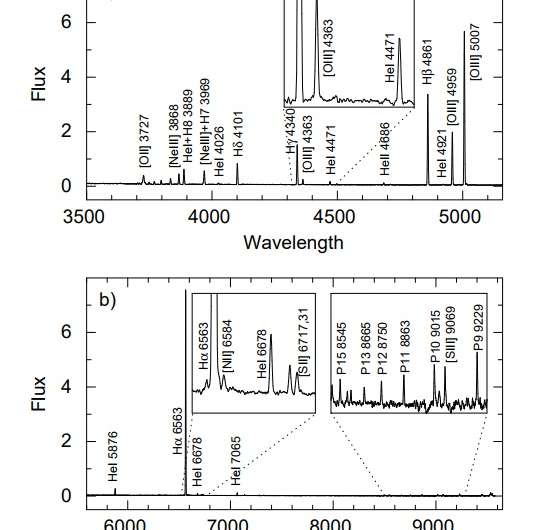The rest-frame LBT spectrum of J0811+4730 uncorrected for extinction. Credit: Izotov et al., 2017.
(Phys.org)—Using the Large Binocular Telescope (LBT), a group of astronomers has found that the star-forming galaxy (SFG) J0811+4730 is the most metal-poor dwarf SFG known to date. The finding is detailed in a paper published online on Sept. 1 on the arXiv pre-print repository.
Metal-poor star-forming galaxies are considered to be the best local analogs of dwarf galaxies at high redshifts that played an essential role in the reionization of the universe. Due to their proximity they offer an excellent opportunity for astronomers to conduct detailed observations and studies that are not possible when it comes to high-redshift galaxies.
J0811+4730 was first identified in 2016 by the Sloan Digital Sky Survey (SDSS) as a compact dwarf SFG with a potential very low metallicity. At a redshift of about 0.04, this galaxy has a SDSS g-band absolute magnitude of -15.41 and a star formation rate of approximately 0.48 solar masses per year.
Now, new spectroscopic observations conducted by a team of astronomers led by Yuri Izotov of the Main Astronomical Observatory in Kiev, Ukraine, reveal that this galaxy is extremely metal-deficient.
For their studies, the researchers used LBT's two spectrographs equipped with high-resolution CCDs. The observations, carried out in February 2017, allowed the team to obtain spectra of J0811+4730, crucial for measuring its element abundances, including its extremely low metallicity.
"In this paper we present Large Binocular Telescope (LBT) spectrophotometric observations of the compact star-forming galaxy (SFG) J0811+4730 selected from the Data Release 13 (DR13) of the Sloan Digital Sky Survey (SDSS)," the astronomers wrote in the paper.
The researchers were able to measure the oxygen content of J0811+4730 and compare it with models to estimate its metallicity. They found that the oxygen abundance of this star-forming galaxy is the lowest ever observed for an SFG. Such low oxygen abundance compared with models indicates that J0811+4730 is the most metal-poor dwarf SFG so far discovered.
"J0811+4730 strongly deviates from the main sequence defined by SFGs in the emission-line diagnostic diagrams and the metallicity – luminosity diagram," the paper reads.
The scientists emphasized that J0811+4730 is strongly offset in oxygen abundance, which was also detected in other galaxies with very low metallicities. However, the cause of this offset is still debated.
Some researchers attribute these deviations to the enhanced brightnesses of the galaxies undergoing active star formation. Others assume that these galaxies can also be chemically unevolved objects with a short star formation history, having metallicities too low for their high luminosities. Furthermore, one hypothesis suggests such offset may be caused by the infall of gas from galactic halos.
"This offset can probably be explained by a combination of its chemically unevolved nature, an enhanced brightness of its star-forming regions, and gas infall resulting in the dilution of the more metal-rich gas in the inner region by the outer more metal-poor gas in the halo," the authors of the paper concluded.
More information: J0811+4730: the most metal-poor star-forming dwarf galaxy known, arXiv:1709.00202 [astro-ph.GA] arxiv.org/abs/1709.00202
Abstract
We report the discovery of the most metal-poor dwarf star-forming galaxy (SFG) known to date, J0811+4730. This galaxy, at a redshift z=0.04444, with a SDSS g-band absolute magnitude M_g = -15.41 mag and a stellar mass M* = 10^6.24} - 10^6.29 Msun, was selected by inspecting the spectroscopic data base in the Data Release 13 (DR13) of the Sloan Digital Sky Survey (SDSS). LBT/MODS spectroscopic observations reveal its oxygen abundance to be 12 + log O/H = 6.98 +/- 0.02, the lowest ever observed for a SFG. J0811+4730 strongly deviates from the main-sequence defined by SFGs in the emission-line diagnostic diagrams and the metallicity - luminosity diagram. These differences are caused mainly by the extremely low oxygen abundance in J0811+4730, which is ~10 times lower than that in main-sequence SFGs with similar luminosities. By fitting the spectral energy distributions of the Sloan Digital Sky Survey (SDSS) and LBT spectra, we find that a considerable fraction of the galaxy stellar mass was formed during the most recent burst of star formation.
© 2017 Phys.org
























